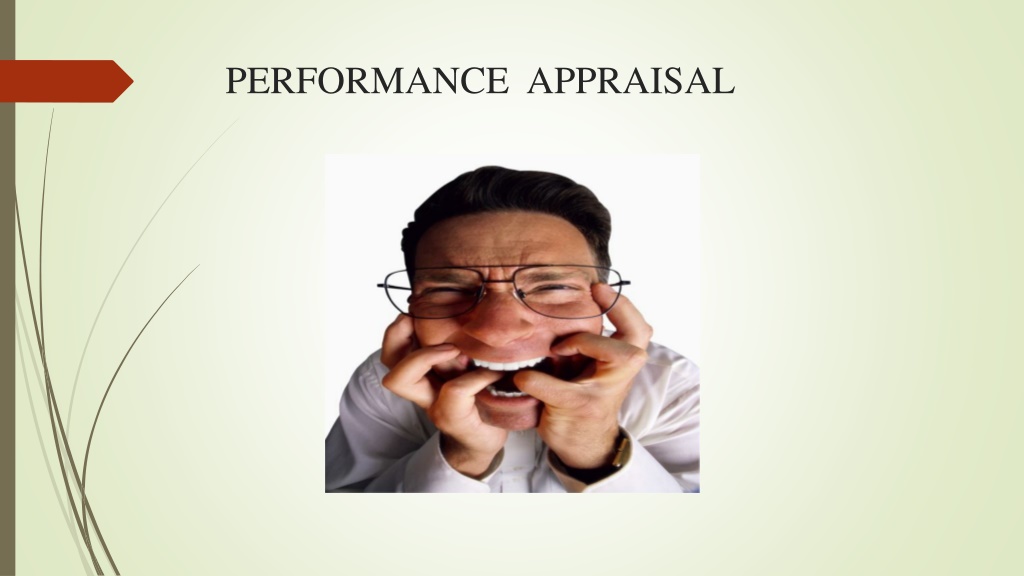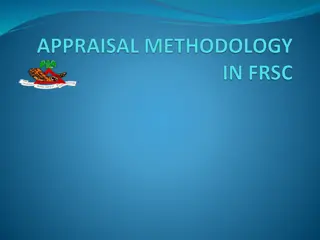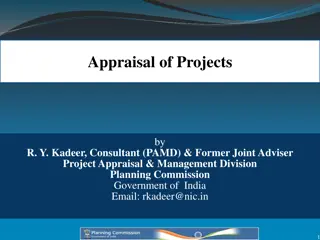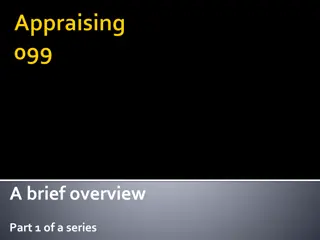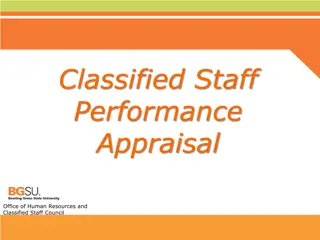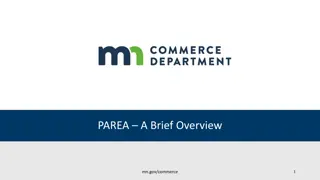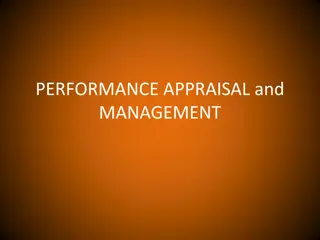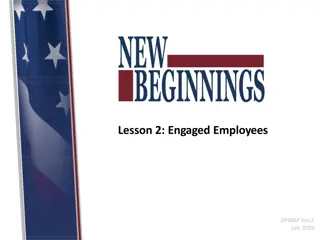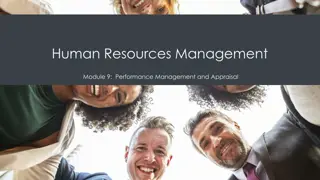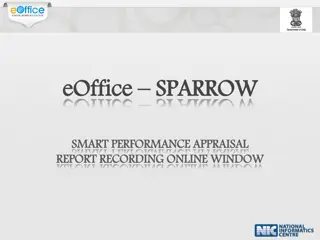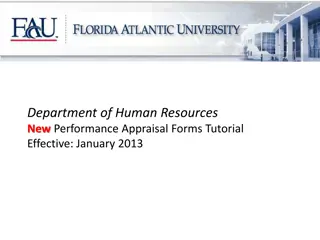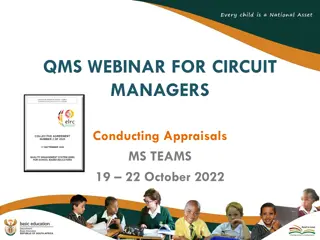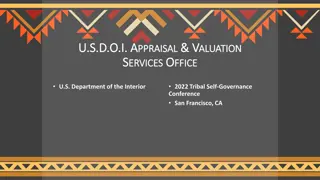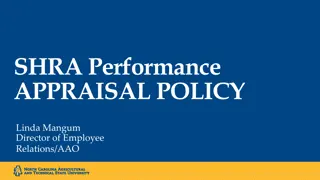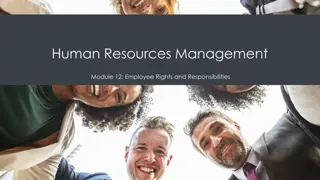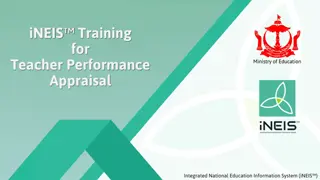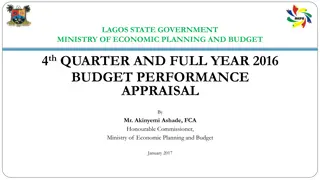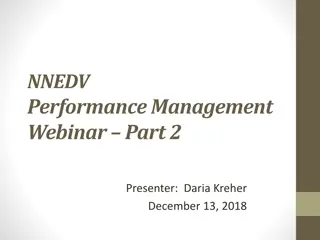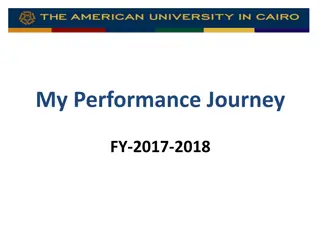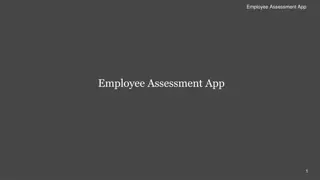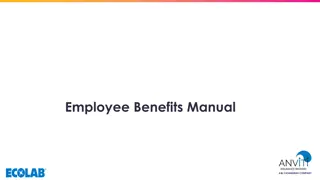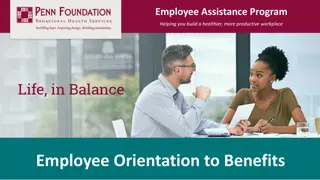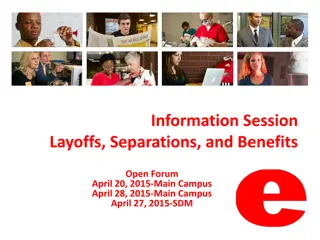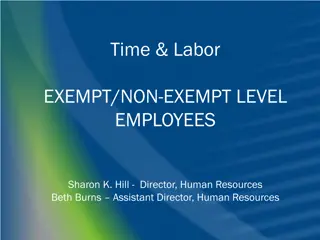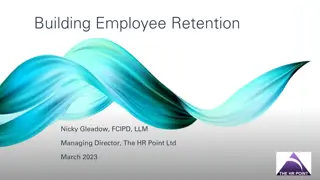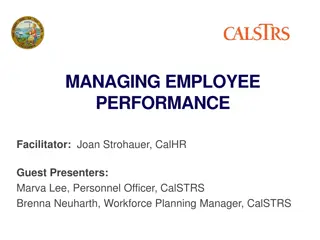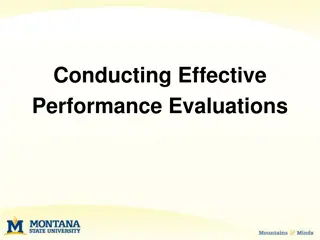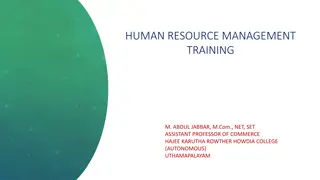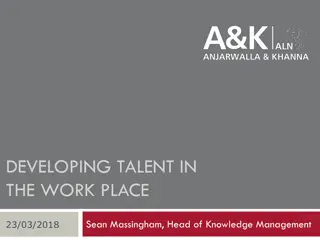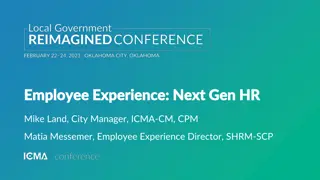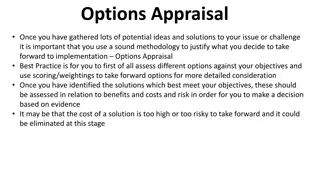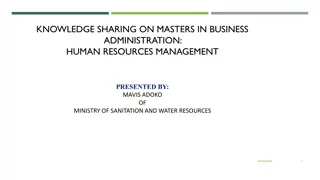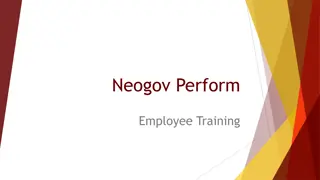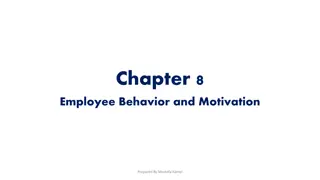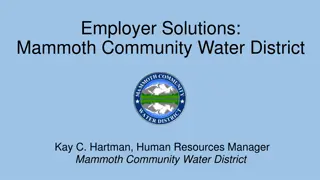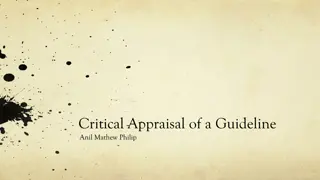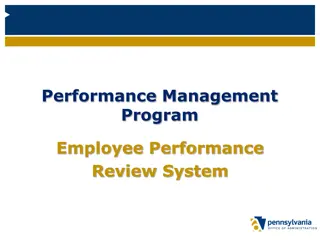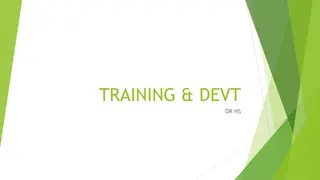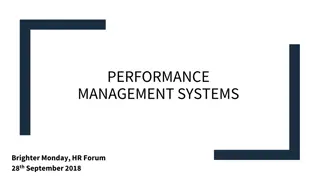Effective Performance Appraisal Strategies for Employee Development
Implementing a successful performance appraisal process involves key elements such as honesty, clear communication, coaching and mentoring, and avoiding surprises during evaluations. It emphasizes self-assessment, preparing and conducting reviews, and finalizing feedback. Rating categories like Outstanding, Very Good, Good, and Fair help in evaluating employee performance effectively.
Download Presentation

Please find below an Image/Link to download the presentation.
The content on the website is provided AS IS for your information and personal use only. It may not be sold, licensed, or shared on other websites without obtaining consent from the author. Download presentation by click this link. If you encounter any issues during the download, it is possible that the publisher has removed the file from their server.
E N D
Presentation Transcript
Honesty Employees being honest with themselves Supervisors having the courage to be honest with their employees Communication between supervisors and employees
Coach and Mentor Focus on building strengths rather than correcting weaknesses
Performance Appraisal Process Self Assessment Prepare the Written Review Conduct the Performance Review Finalize the Written Review
Rating Categories Outstanding (4): Employee is exceptional in all areas of responsibility. Performance significantly exceeds standards and expectations and can be considered a model for the department. Performance at this level is rare and would generally be recognized by peers, immediate supervisor, management, and others. This individual suggests and initiates improvements/changes and through his/her own performance has materially enhanced effectiveness of the department or work area. Performance is generally not equaled by others. For employee evaluations to retain credibility, supervisors should use this rating sparingly. Very Good (3): Employee exceeds most position requirements. Performance at this level consistently exceeds standards and expectations and would generally be recognized by peers and immediate supervisor. Performance is characterized by notable skill, initiative and superior job knowledge. This individual s performance exceeds most other employees in the same or similar position.
Rating Categories Good (2): Employee consistently meets performance standards. The individual performing at this level is considered a fully competent, stable and skilled performer by co-workers and immediate supervisor. Employee may occasionally exceed job performance standards and expectations. This level of performance is what would generally be expected from most competent, experienced employees. Fair (1): Employee meets some performance standards but is deficient in others. Performance does not consistently meet acceptable levels in all areas. Overall performance only meets the minimum standards and expectations. The need for further development and/or improvement is clearly recognized and expected. Performance at this level may cause the department and/or co-workers some problems or inconveniences, or tends to diminish the department s effectiveness and/or productivity. Performance at this level is characterized as just getting by . Employees with an overall performance rating of Fair will be put on notice that the next 1 year performance appraisal must show an overall improvement to Good. No improvement will be grounds for disciplinary action that may lead to termination. Coaching and/or additional training by the supervisor are required.
Rating Categories Unsatisfactory (0): Employee s performance is consistently unacceptable. It is inadequate and below minimum acceptable standards and expectations. There is considerable room for improvement. Performance is causing problems/inconveniences/hardships for the department and/or co- workers and is having a negative impact on departmental effectiveness and/or productivity. This level of performance cannot be condoned or allowed to continue. A continued overall performance rating of Unsatisfactory at the time of the next Interim Performance Review will be grounds for disciplinary action that may lead to termination. Not Applicable (N/A): Employee does not have an opportunity to use this skill.
Overall Rating of Employees Performance Outstanding 80% of performance factors rated 4 with none below 2 Very Good 80% of performance factors rated 3 or better with none below 2 Good 80% of performance factors rated 2 or better with none below 1 Fair 80% of performance factors rated 1 or better Unsatisfactory 80% of performance factors rated 0
Local 153 Overall Performance Rating Factors Performance consistently beyond requirements Performance beyond requirements Competent performer Performance below requirements Performance greatly limited
On the HR Website Employee Performance Evaluation and Development Plan for Professional/Administrative Employees Employee Performance Evaluation and Development Plan for Not- In-Unit Nonexempt Employees Local 153 Self Evaluation Local 153 Performance Evaluation by Supervisors Employee Performance Evaluation and Development Plan Instructions for Supervisors Employee Performance Evaluation and Development Plan Instructions for Employees
On the HR Website Interim Performance Evaluation Instructions for Supervisors Interim Performance Evaluation for Professional/Administrative Employees Interim Performance Evaluation for Not-In-Unit Nonexempt Employees
5 Characteristics of well designed goals Specific What do you want to accomplish? Who is involved? Where Identify a location. When Establish a time frame. Which Identify requirements and constraints. Why - Specific reasons, purpose or benefits of accomplishing the goal.
Measurable Establish criteria for measuring progress toward the attainment of the goal. Set milestones to indicate progress. Plan each step wisely and establish a time frame that allows the employee to carry out those steps.
Attainable Should be realistic and attainable by average employees. May require employees to stretch a bit to achieve them, but should not be extreme.
Relevant Should be related to helping your department/university reach its mission.
Time-bound Goals should be grounded within a time frame starting point, ending point, and fixed duration.
Interim Performance Evaluation Must be done for employees with an Overall Performance Rating of Fair (1) or Unsatisfactory (0). Continued Unsatisfactory performance review should be reviewed with your supervisor & HR prior to meeting the employee. Overall rating of Fair Next 1 year performance appraisal must show an overall improvement to Good (2). Not just for poor performers. Use it as a tool for coaching & mentoring, or to track progress on goals. It s a good opportunity for Communication.
What Motivates Employees? Top 10 MOTIVATORS Rank from 1 10 Good wages Job Security Promotion and growth Good working conditions Interesting work Personal loyalty to employees Tactful disciplining Full appreciation of work done Help with personal problems Feeling of being in on things
What Motivates Employees? Responses from Survey of Employees Top 10 MOTIVATORS Rank from 1 10 1. Good wages 5 2. Job Security 4 3. Promotion and growth 6 4. Good working conditions 7 5. Interesting work 1 6. Personal loyalty to employees 8 7. Tactful disciplining 9 8. Full appreciation of work done 2 9. Help with personal problems 10 3 10. Feeling of being in on things
Top 10 Job Expectations 1. Type of work: the kind of work that makes the best use of one s abilities and gives one a feeling of accomplishment. 2. Security: having a job that provides a steady employment. 3. Company: working for a company that has a good reputation, that one can be proud of working for. 4. Advancement:being able to progress in one s job or career, having the chance to advance in the company. 5. Coworkers: having coworkers who are competent and congenial. 6. Pay:being paid at least enough to meet one s needs, and being paid fairly in comparison to others. 7. Supervision: having an immediate supervisor who is competent, considerate, and fair. 8. Hours: having working hours that allow one enough time with family and/or time to pursue other strong interests and live one s preferred lifestyle. 9. Benefits:having benefits that meet one s needs and compare well with those of others. 10. Working Conditions: having physical working conditions that ae safe, not injurious to health, not stressful, and even comfortable. (Survey published by Career Key 3/16)
Interesting Statistics from WorldatWork 65% of employees do not believe performance ratings accurately and objectively reflect their performance. 58% of employees say that the use of ratings creates a negative experience for everyone except the few at the top. 92% of leaders and 89% of employees believe traditional rankings and ratings should have some role in determining rewards in the future.
This process applies to all non-faculty employees. Except in a case of gross misconduct* where immediate dismissal is deemed to be the appropriate course of action, the Disciplinary Process must be followed before termination may take place.
*Gross Misconduct includes but is not limited to fighting, threats of bodily harm, possessing a dangerous weapon, alcohol, or illegal substance on university premises, theft, falsifying time and other records. * immediate dismissal or suspension pending investigation may be the appropriate course of action In cases of gross misconduct, the AVP of Human Resources must be contacted.
Prior to terminating an employee for poor performance, coaching/counseling is a required course of action. The University s Progressive Disciplinary Process must be followed in its entirety as described below.
Reminder- Local 153 Union Members must be given the option to have a campus union representative present at all coaching/counseling meetings.
First Step Supervisor meets with employee to clearly define the problem. Gives clear information on the steps the employee must take to correct the problem and meet the standards set by the supervisor. Offers the employee any reasonable help that will correct the problem. Schedule a second meeting date at a time that gives the employee a reasonable time to correct the problem. Complete Employee Guidance Record, OR send an email following up on the discussion, outlining where improvement is warranted and steps discussed to achieve improvement. Note: If the Employee Guidance Record is used, request that the employee sign. If the employee refuses to sign, make a note on the bottom of the form and provide the employee and the Associate Vice President of Human Resources with a copy.
Second Step If by the time the second meeting takes place the problem has been corrected, complete the Employee Guidance Record OR send an email indicating that the negative performance has improved.
If the problem continues to exist, contact the Associate VP of Human Resources to inform and discuss scheduling the 2nd disciplinary meeting. Proceed to complete the Employee Guidance Record OR a summary of the continued concerns in advance of the meeting. The document must indicate that the employee will be subjected to disciplinary action up to and including termination if the problem has not been corrected by the time of your third and final meeting. Schedule the third and final meeting, allowing a reasonable amount of time for the employee to correct the problem.
Third Step If by the time the third meeting takes place the problem has been corrected, complete the Employee Guidance Record OR send an email indicating that the negative performance has improved. If the problem has not been corrected, please contact the Associate Vice President of Human Resources in advance of the third meeting to discuss the lack of improvement. The AVP of Human Resources will discuss if disciplinary action or termination is warranted. The third meeting will include the AVP of Human Resources or designee to discuss the discipline/termination decision.
Tips for conducting a successful disciplinary meeting Do not delay Avoid chitchat at the start of a meeting acknowledge immediately this is going to be a difficult meeting Provide examples talking in genialities provides little guidance to remedy the issues Avoid focusing on intent ( You re not trying ) it cannot be proved and it may appear as an attack when attacked employees fight back Stay away from why? - don t speculate instead you can say: we want you to succeed is there anything we can do to help? This could lead to a potential discrimination claim
Tips for conducting a successful disciplinary meeting (Continued) Make no excuses don t take responsibility unless you are responsible Watch for code words Some comments may be construed as discrimination such as you are too emotional Avoid absolutes do not say you always or you never it s better to say almost always Listen you must give the employee an opportunity to talk. It important to hear what an employee says as what they do not say. Be aware of eye contact and body language (face the employee with good posture and eye contact and be engaged do not be distracted by other work) Be aware of the tone of your voice don t sound apologetic (might diminish the sense of seriousness). Are you calm? Are you firm?
Mock disciplinary Meeting Background Pat is a long term employee at a large fitness center. Pat is a member of a protected class. Pat is the assistant to the Jo, the General Manager. Pat s responsibilities include fielding calls and in-person inquires when Jo is out of the office or in meetings, scheduling maintenance for equipment, posting the weekly information of mandatory meetings to the staff, and assisting with other projects as needed.
Mock Disciplinary Meeting Issues in the workplace For the past several months Pat has been consistently late to work. Pat started being 5 minutes or so tardy to work at first. However, Pat s tardiness is now exceeding 30 minutes almost every work day. Other employees have relayed to Jo Pat is often inappropriate with the members. Pat is alleged to having yelled at members for requesting such items as additional towels in the locker rooms. Pat has also been seen giving some members special treatment and providing them with free items from the juice bar and acting flirtatious (along with patting members as they walk by). The fitness center has recently had problems with the pool company used for weekly maintenance of the indoor Olympic sized pool. Jo asked Pat to research other pool companies and provide a comparison spreadsheet to understand types of services and costs of each of the local pool companies. Pat missed the deadline and the current pool company was a no show for their weekly maintenance. Jo had to quickly step in and find a pool company to service the pool without having to disrupt the members by closing the pool while awaiting service.
Inappropriate Dialogue Jo: better after having the flu last week? Pat: She s feeling better but I had to help her with all her food shopping, driving her to the pharmacy, and helping her around the house. It has been a tough week. I really did not get to enjoy the nice weather this weekend. Jo: (do not make eye contact - turn body away): I m sorry to have to talk with you but the real reason I asked you to come in is because of your recent performance. It just has not been adequate and you need to do a better job. (Start to look at computer screen) Pat: That s not true. The members love me and I do my work. Jo (yell as if you were scolding your child): done on time. Pat: That s not true. I have only been late this past week because of my mom and I was late with the pool company information because Jo:(interrupt me by starting the next line) Jo: No, Pat you were late consistently for past several months and the pool company project is just one request that was not completed. You missed sending out last week s meeting reminder. Stop being rude to the customers when they ask for towels and do not give out free items from the juice bar or flirt with the members. We will meet again in 1 week. Hi Pat, how was your weekend? It was such perfect weather. Is your Mom feeling You re always late and projects are never
Appropriate Dialogue Jo (Make good eye contact and posture): Pat, I asked that you meet with me today to discuss recent performance issues. We will be discussing your tardiness with attendance and missing project deadlines as well. We will also be discussing customer service issues. Pat: What do you mean? I have only been late a few times and Taylor is late a lot. I only missed one email reminder to the staff about the weekly meeting. Jo:We are not here to talk about others behavior. We are here to talk about you and what needs to change. You recently also missed the deadline to research the pool companies Pat (looks down becoming sad): I m sorry. Work has been so difficult for me. I have been having trouble with my eyes. My doctor says a magnifying screen will help but I am too afraid to ask. I am afraid I may lose my job. Jo: I will discuss this with Human Resources and we will have a follow up meeting. We also need to discuss customer service. I have noticed and have been told you are yelling at members. Also, you must arrive to work on time. This is not acceptable behavior. Do you want to be successful? Pat: Yes, this is a wonderful place to work and I understand. I have been so frustrated about the difficulties on the computer. I will work on my communication and my timeliness to work Jo: We will have a follow up discussion in 1 week. I will discuss the magnifying screen with Human Resources. Please greet the members in a friendly manner and speak to me about computer projects that may be difficult. If you need to speak with me before then, please let me know.
